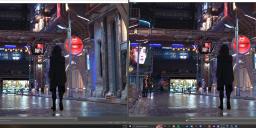No matter what the image is VERY pixeladed.
in The Commons
No matter what I change "Pixel Denoiser Start Iteration" or "Pixel Filder Radius" the images look like sand. How do I remove this much noise?


Grainy.jpg
7680 x 2160 - 4M


Comments
Lots of shiny surfaces and localised light sources are a challenge. How long are you letting it render?
@pectabyte: If i see it right, you are not using DOF, you have seven figures in the scene (if they are not billboards/figureflats) and you render 4k in a dark setting. IDK how much VRAM you have, but even if you can render with GPU that should take quite a long time. You could make the scene brighter and darken in postwork, and you could spotrender especially grainy parts isolated to add in postwork, so you don't have to render like forever.
And AFAIK without GPU, there is no Denoiser active, so if you are rendering CPU only because the scene exceeds your vram, you have to cope without that function.
Figures can be rendered seperately and added in postwork, also some of the lights could be turned of and added (painted) in postwork. And of course you could also create billboards/figureflats to replace some figures, which would save you a lot of vram.
Rendering takes : time. People are so used to real-time video games rendering engines and GPU acceleration for pre-calculated 3D, that they want a perfect image in an hour.
Pixar/Disney for example, have huge computer farms to render, they had approximately 24000 cores to calculate each frame of Inside Out in 2015. And with that much power (25th largest computing power in the world) it still took them about 2 full years to calculate all frames. And it'd have taken about 400 years 24/7 to calculate 90 minutes on a home computer.
If it's graingy, it's because the lighting in your scene is complex. And you can't expect a magically clean result without patience. Don't use denoise (if your computer is powerful enough it's better not to) and let the render run for as long as it takes. Even with an i9-12900 and RTX 3090 (if ! the scene fits in the VRAM), it'd probably take 6 hours at the very least to get something without too much noise.
Try to render at 50% more than the final dimension and 2D resize the render (with resampling), this will approximate missing pixels and result will look cleaner and much sharper than a denoise.
Rendering is incredibly faster nowadays thanks to NVidia. But still... it takes a lot of time. That's just a fact, no way around.
Being patient ;) Render by night when you're asleep.
Or render once. With some noise. Then continue the render for a few more samples and activate this time a denoise. This way you'll have two versions of the render and you'll be able to layer that in a 2D app to get the better of both images.
why is the denoiser a negative number
-560
Either give it longer, or remove the grain after rendering (I do the latter).
I use this tool by mCasual: https://www.daz3d.com/forums/discussion/334881/a-i-based-open-source-de-noiser-for-daz-studio-pc-and-macs/p1
Although, (to be honest) I haven't had a grain-free render since 4.19. :/
Indeed ;) I didn't notice the -520. That's just... super weird. Doubt a negative value mean anything.
On such an image I would probably let the denoiser kick in at about 2000 samples, minimum. If pixels didn't receive enough of their final estimated color, a too early denoise gives away mushy pixels.
I'm currently rendering an animation that is nowhere near the complexity or render quality of a Pixar movie, and even with one of the most powerful CPUs currently on the market, it's still taking around 15 minutes per frame to look decent and not just be a sheet of noise.
In Render Settings -> Filtering:
Play with Nominal Luminance:
0.00 = Iray uses auto guessing = it tries to keep the contrast between max. bright pixesl and max. dark pixels while redrucing fireflies. In your scene you have dark ambient light and hot spot neon signs. That means high contrast. This is difficult to clean for Iray.
If you set Nominal Luminance to 1 (just as a try) you tell Iray it should tune down the hot bright pixels within its algorythm. This will limit the contrast in your scene but helps for faster cleanup.
The value 1 is just a guess, because it depens on the indvidual scene. If your result is to flat (low contrast), try with 2 and so on. Or, if it is still to contrasty, try with 0.5.
(This is all a guess based on my experience with scenes like that. Sometimes it helps a lot sometimes it is not very useful.)
4.16 was the last before 4.20.